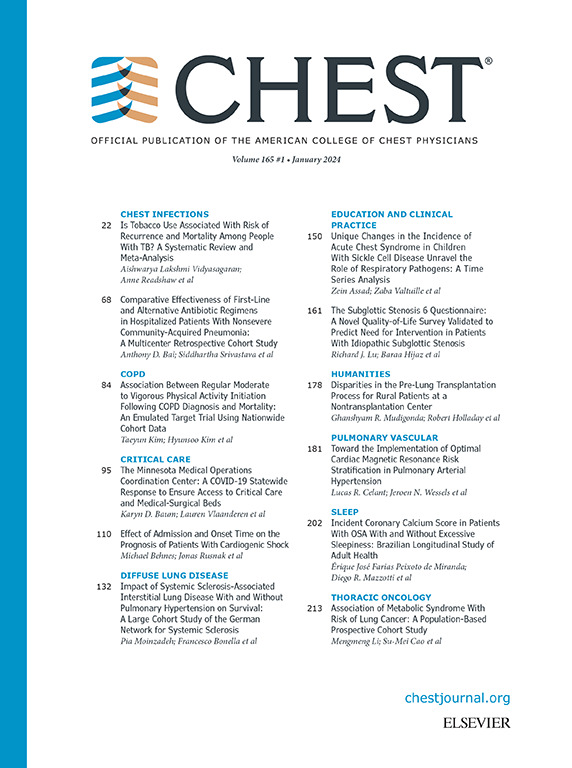A 29-Year Old Man With an Enlarging Lung Lesion With Calcifications Giving Finger-in-Glove Appearance.
IF 8.6
1区 医学
Q1 CRITICAL CARE MEDICINE
引用次数: 0
Abstract
A 29-year-old man with a medical history of chronic rhinosinusitis presented with a 6-month history of chronic nonproductive cough and mild exertional dyspnea. Five years ago, at the time of his chronic rhinosinusitis diagnosis, he underwent a chest radiograph that revealed an ill-defined opacity in the middle zone of the left lung, suspicious for neoplasm, and was subsequently lost to follow-up, until he presented now with cough and dyspnea. There was no history of hemoptysis, epigastric discomfort/burning sensation, dysphagia, or post-tussive vomiting associated with cough. Exertional dyspnea was graded as modified Medical Research Council grade 1, and it was not associated with any diurnal or postural variations (orthopnea/trepopnea), chest pain, palpitations, or pedal edema. There was no history of fever, malaise, weight loss, or audible wheeze. The patient had no significant medical history of asthma, COPD, nasal obstruction, urticaria, or other chronic respiratory conditions. He did not smoke and reported no significant occupational or environmental exposures to allergens. There was no history of TB contact or recurrent respiratory infections. Additionally, there was no family history of similar respiratory findings or conditions. During the intervening years, the patient remained asymptomatic until his presentation with the new concerns.一名29岁男性,肺肿大伴钙化,呈手套状。
29岁男性,有慢性鼻窦炎病史,有6个月慢性非生产性咳嗽和轻度用力性呼吸困难。五年前,当他被诊断为慢性鼻窦炎时,他进行了胸片检查,发现左肺中部有一个模糊的混浊影,怀疑是肿瘤,后来没有随访,直到现在他出现咳嗽和呼吸困难。患者无咯血、上腹不适/烧灼感、吞咽困难或咳后呕吐史。劳力性呼吸困难被医学研究委员会评定为1级,与任何昼夜或体位变化(直喘/胸闷)、胸痛、心悸或足部水肿无关。没有发热、不适、体重减轻或可听到喘息的病史。患者无明显哮喘、慢性阻塞性肺病、鼻塞、荨麻疹或其他慢性呼吸系统疾病病史。他不吸烟,也没有报告有明显的职业或环境过敏原暴露。无结核接触史或反复呼吸道感染史。此外,没有类似呼吸道疾病的家族史。在此期间,患者一直无症状,直到他提出了新的担忧。
本文章由计算机程序翻译,如有差异,请以英文原文为准。
求助全文
约1分钟内获得全文
求助全文
来源期刊

Chest
医学-呼吸系统
CiteScore
13.70
自引率
3.10%
发文量
3369
审稿时长
15 days
期刊介绍:
At CHEST, our mission is to revolutionize patient care through the collaboration of multidisciplinary clinicians in the fields of pulmonary, critical care, and sleep medicine. We achieve this by publishing cutting-edge clinical research that addresses current challenges and brings forth future advancements. To enhance understanding in a rapidly evolving field, CHEST also features review articles, commentaries, and facilitates discussions on emerging controversies. We place great emphasis on scientific rigor, employing a rigorous peer review process, and ensuring all accepted content is published online within two weeks.
 求助内容:
求助内容: 应助结果提醒方式:
应助结果提醒方式:


